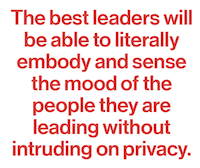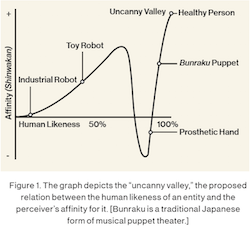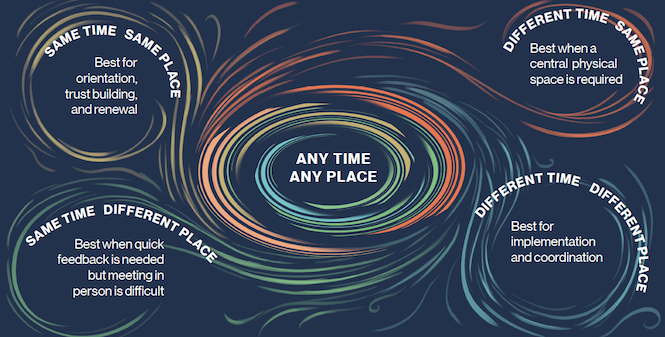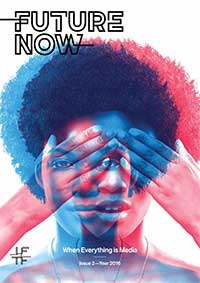Future Now
The IFTF Blog
Better Than Being There
I used video teleconferencing for the first time in 1973. The video wasn’t very good and the audio was worse, but otherwise the design vision was pretty much the same as the systems of today: an invisible wall between two groups of people able to see and hear each other. In time, that design vision trusted, the view of each other will become holographic and perhaps the two sides will even be able to virtually reach through the glass and touch each other using some form of haptic interface. This might seem like we’re on the path to progress, but innovation in video teleconferencing seems to be driven by a kind of unconscious horseless-carriage logic that troubles me. The design vision seems to be based in an unexamined assumption that in-person meetings are the ultimate form of human communication, so the closer virtual meetings can get to in-person, the better. Rather than designing to simulate being there, I think we should be designing to be better than being there.
Avoiding the “Uncanny Valley”
Emerging technologies such as augmented reality and virtual reality will provide new opportunities to communicate more effectively, productively, and persuasively than ever before. And moving forward, they will also open the doors to forms of remote presence that could be off-putting and alienating. This has a parallel to an idea that was touched upon in 1970, when a robotics professor named Masahiro Mori at the Tokyo Institute of Technology wrote a classic essay in which he coined the vivid term “uncanny valley” to describe how humans react to humanoid robots. Essentially, the more human-like a robot appears to be, the more positively we react to it. That is, until they come very close to looking like an actual human, but are still recognizable as non-human, and the dissonance creates an uncanny, unsettling feeling in us. A robot with a cartoon-like face is more appealing to most people than a robot with no face. But a robot that looks like a living mannequin is close enough to human that it makes us uncomfortable.

As we move into a world of ambient communications, we will likely see a similar uncanny valley emerge for leadership-at-a-distance. In climbing toward the goal of leaders being there without being there, our affinity for those leaders will increase as their virtual presence increases—until we reach an uncanny valley where leaders are perceived as being weirdly or inappropriately present.
In a world of networked, ambient communications, leaders will be able to be present in the background much more of the time. This could be reassuring in some situations, but eerie in others. Leaders will be able to monitor performance with much greater detail, even if they are not physically present. What used to be called “workflow systems” will be capable of much more detailed monitoring of progress—or lack of progress—through a ubiquitous mesh of sensors. Blended reality leadership presence could become Big Brother incarnate, with performance monitoring turning into eavesdropping, measuring employees’ stress levels and emotional states, and cataloging worker output on a minute-by-minute basis. Such tracking might even help leaders in the short-term, but the behavior would cross into the uncanny valley of inhumane co-presence that is unwanted, uninvited, and difficult to shake.

On the other side of the uncanny valley, though, is a kind of presence that will be better than in person. And though technology will have an important role in enabling this kind of presence, the best examples of it today involve no technology at all. I have worked with several companies over the years where the founder had such strong leadership presence that it was like they were there with us in the room. At W.L. Gore & Associates, founder Bill Gore was such a charismatic presence that he continues to live throughout the company. His eloquent quotes are on the walls and his presence is baked into the culture. At most meetings that I have attended at Gore, someone referred to “Bill” at least once. Again, it was as if he were there with us, even though he is no longer living. His presence is an essential part of their culture. Many of today’s Gore leaders seem to embody Bill’s values and priorities across the generations. Again, however, this kind of founder presence could become uncanny and unproductive if taken to extremes.
If magnetic leaders, with clear and consistent values and vision, can project a presence even when they are no longer alive, how might a living leader be present while lacking only physical proximity? Of course, to begin with, a leader needs a vivid presence that is strong and worth sharing. But taking that as a given, the next decade presents new opportunities for communicating whatever leadership presence you have as effectively as possible over long distances. The best leaders will figure out how to be there without being there—while skirting or passing through the uncanny valley of eerie over-connection.
Principles for Navigating Blended Reality Leadership

In 2026, leaders will need to become skilled at choosing which medium will best communicate their style of leadership. Here are some principles to help you start understanding the affordances of this world and learning how to navigate them.
Sharable Presence for Leaders and Co-workers:
This will be a world where co-presence will be possible, even when people are not physically present together in the same place at the same time. Mixed-reality experiences will be able to be shared across distances. The best leaders will have much more vivid shared work and life experiences with the people they lead. Physically distant leaders will want to feel close—but not too close.
Biomedia Sensors to Link Leaders, Workers, and Work:
This will be a world where connected sensors are ubiquitous. Some of them will be in our bodies. Moreover, leaders (and everyone else) will have a newfound ability to make sense out of all the data those sensors collect. These embodied systems will link to and respond to biomarkers from workers. The best leaders will be able to literally embody and sense the mood of the people they are leading without intruding on privacy.
Respectfully Measuring Productivity
This will be a world where the outcomes of work will become much more explicit and measurable, “8 to 5” jobs will yield to ways of making a living that are focused on outcomes, not physical presence. Progress tracking will become much easier, but the same abilities will raise the key question of what should be tracked and what constitutes progress. The potential for worker abuse will rise, as systems will have the ability to measure almost everything and sometimes measure the wrong things. The best leaders will figure out ways to track and guide the progress of work, without prying or preying.
New Blended Reality Leadership Literacies
This will be a world where leaders will need to be skilled in the art and science of being there without being there. There are some general directions of change—leaders will have to shift from thinking about where people are physically to what their circumstance and mindstate are wherever they might be, and scheduling will become a dynamic and ad hoc process. On the whole, communications strategies will have to become much more situational.
Today, we can start looking systematically at what kinds of presence are best for which leadership goals. For instance, things like building trust and orienting new hires require people to meet in person.
In the next decade, these five modes of communication will each be further augmented by ambient communication technology. Leaders will need to master each of them, learning how to choose the right mode of communication to meet their goal. They will need new blended reality skills to be better than being there—without getting stuck in the uncanny valley.
 FUTURE NOW—When Everything is Media
FUTURE NOW—When Everything is Media
In this second volume of Future Now, IFTF's print magazine, we explore the future of communications. In our research process, we traced historical technology shifts through the present and focused on the question, “what is beyond social media?”
Think of Future Now as a book of provocations; it reflects the curiosity and diversity of futures thinking across IFTF and our network of collaborators. It contains expert interviews, profiles and analyses of what today’s technologies tell us about the next decade, as well as comics and science fiction stories that help us imagine what 2026 (and beyond) might look and feel like.
For More Information
For more information on IFTF's Future 50 Partnership and Tech Futures Lab, contact:
Sean Ness | sness@iftf.org | 650.233.9517



